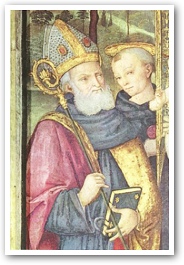The Real St. Nicholas
- FR. WILLIAM SAUNDERS
Is there a Santa Claus?
 |
Yes, there is a Santa Claus. However, we know him more as St. Nicholas. Unfortunately, we have little historical evidence about this popular saint. Tradition holds that he was born in Patara in Lycia, a province in Asia Minor. He was born to a rather wealthy Christian family and benefitted from a solid Christian upbringing. Some say that at age five he began to study the teachings of the Church. He practiced virtue and piety.
His parents died when he was young and left him with a substantial inheritance, which he used for many good works. One popular story tells of a widower who had three daughters. He was going to sell them into prostitution since he could not afford to provide the necessary dowries for their marriages. St. Nicholas heard of the plight of the daughters and decided to help. In the dark of the night, he went to their home and tossed a bag of gold through an open window of the man's house, thereby supplying the money for a proper dowry for the oldest daughter. The next two nights, he did the same. St. Nicholas' generosity spared the girls from a sad fate.
St. Nicholas' reputation as a holy man spread. Upon the bishop's death, St. Nicholas was chosen to succeed him as the Bishop of Myra. Several accounts agree that St. Nicholas suffered imprisonment and torture for the faith during the persecution waged by Emperor Diocletian in the latter part of the 300s. Some sources attest that after the legalization of Christianity, he was present at the Council of Nicea (325) and joined in the condemnation of the heresy of Arianism, which denied the divinity of Christ. A later story tells of how St. Nicholas intervened to spare three innocent men sentenced to death by a corrupt governor named Eustathius, whom St. Nicholas confronted and moved to do penance. He died in the fourth century between the years 345 and 352 on Dec. 6th, and was buried at his cathedral.
St. Nicholas has been continually venerated as a great saint. In the sixth century, Emperor Justinian I built a church in honor of St. Nicholas at Constantinople, and St. John Chrysostom included his name in the liturgy. In the 10th century, an anonymous Greek author wrote, "The West as well as the East acclaims and glorifies him. Wherever there are people, in the country and the town, in the villages, in isles, in the furthest parts of the earth, his name is revered and churches are built in his honor. All Christians, young and old, men and women, boys and girls, reverence the memory and call upon his protection." After the Moslem invasion and persecution of Christianity, his body was taken by Italian merchants in 1087 and entombed in a new church in Bari, Italy.
The devotion to St. Nicholas was distorted by the Dutch Protestants, who wanted to erase his "Catholic trappings." For instance, St. Nicholas was rendered Sint Klaes and later Santa Claus. They also stripped him of his bishop's regalia and made him a more nordic looking Father Christmas with a red suit.
In the 19th century, American authors also helped change the "bishop's image" of St. Nicholas. In 1820, Washington Irving wrote a story of Santa Claus flying in a wagon to deliver presents to children. Three years later, Clement Moore wrote A Visit from St. Nicholas (known better as The Night Before Christmas, describing Santa Claus as a "jolly old elf" a round belly, cheeks likes roses and a nose like a cherry. In 1882, Thomas Nast drew a picture of Santa Claus based on Moore's description and even added that the North Pole was his home. Finally, Haddom Sundblom, an advertising artist for Coca-Cola, transformed Santa Claus into the red-suited, bigger-than-life and even Coke-drinking jolly character we easily picture in our minds today.
Nevertheless, is there a Santa Claus? I remember reading once the response of the editor of The New York Sun in 1897 to an 8-year-old girl named Virginia who asked the same question. Part of the answer, which still applies, was this: "Yes, Virginia, there is a Santa Claus. He exists as certainly as love and generosity and devotion exist, and you know that they abound and give to your life its highest beauty and joy. Alas! How dreary would be the world if there were no Santa Claus! It would be as dreary as if there were no Virginias. There would be no childlike faith then, no poetry, no romance to make tolerable this existence. We should have no enjoyment, except in sense and sight. The external light with which childhood fills the world would be extinguished.... Nobody sees Santa Claus but that is no sign that there is no Santa Claus. The most real things in the world are those that neither children nor men can see.... Thank God! He lives, and he lives forever." For me, this is a pretty good testimonial of St. Nicholas and the joy he brings to our Christmas celebration. May St. Nicholas inspire us with his prayers and example to celebrate a faith-filled Christmas.
 This is J. Fraser Field, Founder of CERC. I hope you appreciated this piece. We curate these articles especially for believers like you.
This is J. Fraser Field, Founder of CERC. I hope you appreciated this piece. We curate these articles especially for believers like you.
Please show your appreciation by making a $3 donation. CERC is entirely reader supported.

Acknowledgement
Saunders, Rev. William. "The Real St. Nicholas" Arlington Catholic Herald.
This article is reprinted with permission from Arlington Catholic Herald.
The Author

 Father William Saunders is pastor of Our Lady of Hope parish in Potomac Falls, Virginia. He is dean of the Notre Dame Graduate School of Christendom College. The above article is a "Straight Answers" column he wrote for the Arlington Catholic Herald. Father Saunders is the author of Straight Answers, a book based on 100 of his columns, and Straight Answers II.
Father William Saunders is pastor of Our Lady of Hope parish in Potomac Falls, Virginia. He is dean of the Notre Dame Graduate School of Christendom College. The above article is a "Straight Answers" column he wrote for the Arlington Catholic Herald. Father Saunders is the author of Straight Answers, a book based on 100 of his columns, and Straight Answers II.


